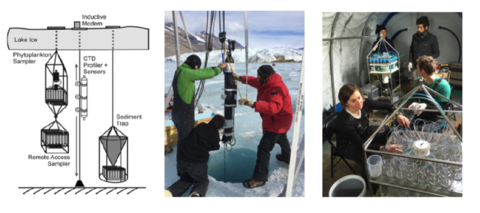
In 2012, Doran, Priscu, and Takacs-Vesbach were awarded a NASA equipment grant under the Exobiology Program to purchase a suite of autonomous lake sampling and monitoring equipment to acquire year-round physical and biological data for the first time. This grant was followed by an NSF EAGER award to establish the equipment in Lake Bonney and keep it running for a number of years. The ALPS equipment includes an Ice-tethered profiler (ITP), phytoplankton sampler (PPS) and remote access sampler (RAS) (Fig. 1). The ITP carries onboard sensors for temperature, conductivity, photosynthetically active radiation (PAR) and a fluoroprobe for evaluating different algal classes. The PPS and RAS collect ~ every 18 days; the PPS collects and preserves water column filtrate and the RAS collects 500 ml water samples. A pre-existing (since November 2000) carousel sediment trap system is also now part of the ALPS system.
ALPS data revealed the first changes in chl-a measured with the fluoroprobe during the polar night. Winter chl-a peaks were associated with an increase in mixotrophic haptophytes and cryptophytes. Collectively our data reveal that phytoplankton groups possessing variable trophic abilities are differentially competitive during seasonal scales owing to periods of higher nutrients (photoautotrophs) vs. light/energy limitation (mixotrophs) (Patriarche et al in review). In addition, bacterioplankton community composition changes were observed in the relative abundance of 16S rRNA gene amplicons. Specifically, members of the Firmicutes decreased by nearly 90%, whereas Bacteroidetes amplicons doubled. These changes were associated with increases in chloroplast amplicons, suggesting that interactions among bacteria and mixotrophic grazers are significant in winter.
In MCM5 we proposed to move the ALPS equipment into other TV lakes. The first year of MCM5 we removed the ALPS equipment from Lake Bonney and returned it to the U.S. for rebuilding and recalibration. We have successfully redeployed ALPS in Lake Hoare in November 2019, and then next season a second set up will be deployed in Lake Fryxell. Each set of ALPS equipment will be deployed for two years in Lakes Hoare and Fryxell, and they will share a year of overlap (2020-2021) enabling us to make inter-lake comparisons.
